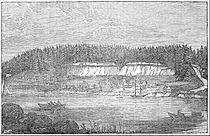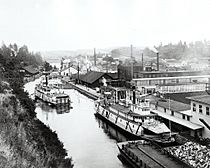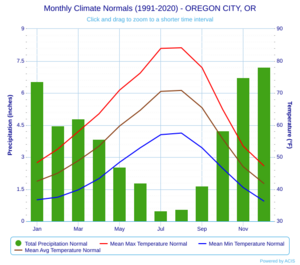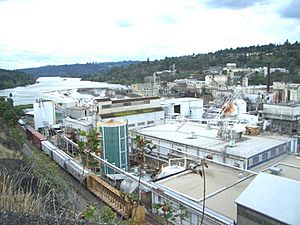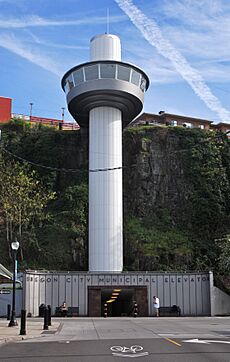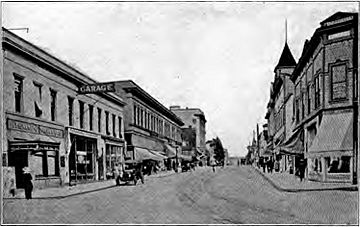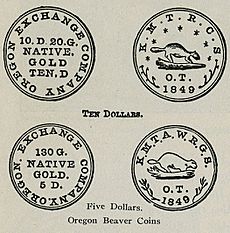Oregon City, Oregon facts for kids
Quick facts for kids
Oregon City, Oregon
|
||
|---|---|---|
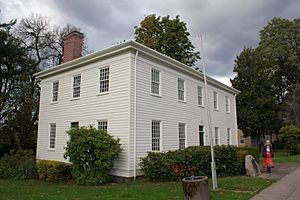
The McLoughlin House, est. 1845
|
||
|
||
| Nickname(s):
End of the Oregon Trail, OC
|
||
| Motto(s):
Urbs civitatis nostrae prima et mater (English: First and mothertown of our state)
|
||

Location in Oregon
|
||
| Country | United States | |
| State | Oregon | |
| County | Clackamas | |
| Founded | 1829 | |
| Incorporated | 1844 | |
| Area | ||
| • Total | 10.29 sq mi (26.64 km2) | |
| • Land | 10.05 sq mi (26.03 km2) | |
| • Water | 0.24 sq mi (0.61 km2) | |
| Elevation | 466 ft (142 m) | |
| Population
(2020)
|
||
| • Total | 36,975 | |
| • Density | 3,738.88/sq mi (1,443.54/km2) | |
| Time zone | UTC−8 (PST) | |
| • Summer (DST) | UTC−7 (PDT) | |
| ZIP code |
97045
|
|
| Area code(s) | 503 and 971 | |
| FIPS code | 41-55200 | |
| GNIS feature ID | 2411332 | |
| Website | www.orcity.org | |
Oregon City is the main city of Clackamas County, Oregon, United States. It is located on the Willamette River, close to the big city of Portland. In 2020, about 37,572 people lived there.
Oregon City was started in 1829 by the Hudson's Bay Company. In 1844, it became the first U.S. city west of the Rocky Mountains to be officially recognized as a city.
Contents
History of Oregon City

For many years, Oregon City was known for its large paper mills along the Willamette River. This city played a very important part in the early history of the Oregon Country.
Dr. John McLoughlin from the Hudson's Bay Company started Oregon City in 1829. He chose a spot near where the Clackamas River meets the Willamette River. This was a good place because the powerful Willamette Falls could be used to run a lumber mill.
During the 1840s and 1850s, Oregon City was the final stop for people traveling the Oregon Trail. Many pioneers came here to claim land.
Oregon's First Capital
Oregon City was the capital of the Oregon Territory from 1848 until 1851. It was a strong rival to Portland for being the most important city in the area.
In 1846, the city's newspaper, the Oregon Spectator, was the first American newspaper printed west of the Rocky Mountains. Also, the Beaver Coins Mint in Oregon City made special coins for the Oregon Territory in 1849. These coins were used for a short time.
Many old houses and buildings from when the city was founded are still standing. They help keep the city's historic feel alive.
Geography and Unique Features
Oregon City is split into two main parts: an upper area and a lower area. The lower part is right next to the Willamette River. The upper part is on top of a tall cliff.
For many years, people used trails and then stairs to go between the two levels. In 1915, the city built the Oregon City Municipal Elevator. This special elevator connects the upper and lower parts of the city. It was first powered by water, then by electricity in the 1920s. A new electric elevator was built in 1952.
The city covers about 9.29 square miles (24.06 square kilometers). Most of this is land, with a small amount of water. The main rivers are the Willamette River and the Clackamas River. The Willamette River forms the border between Oregon City and West Linn. The Clackamas River forms the border between Oregon City and Gladstone.
Willamette Falls and Early Electricity
The Willamette Falls Locks in West Linn were the first multi-level boat locks in the United States. They are now a National Historical Site, but they are no longer used.
Oregon City was also home to a big step in electricity. In 1889, the first long-distance electric power service in the United States started here. It sent electricity 14 miles (23 km) to Portland.
Climate of Oregon City
Oregon City has a Mediterranean climate. This means it has hot, dry summers and cool, wet winters.
The average temperature throughout the year is about 55.4°F (13°C). The warmest months are July and August, with an average of 70.8°F (21.6°C). December is the coldest, averaging 41.8°F (5.4°C).
The city gets about 44.81 inches (113.8 cm) of rain each year. Most of the rain falls in winter, from November to March. July and August are much drier.
Temperatures in Oregon City can vary a lot. There are usually 122 days a year when it's warmer than 70°F (21°C). About 18 days are hotter than 90°F (32°C), and sometimes it gets over 100°F (38°C). Very cold days are rare, with the temperature staying below 32°F (0°C) less than once a year. The coldest temperature ever recorded was -2°F (-19°C) in 1950, and the hottest was 114°F (46°C) in 2021.
| Climate data for Oregon City (1991−2020 normals, extremes 1948−present) | |||||||||||||
|---|---|---|---|---|---|---|---|---|---|---|---|---|---|
| Month | Jan | Feb | Mar | Apr | May | Jun | Jul | Aug | Sep | Oct | Nov | Dec | Year |
| Record high °F (°C) | 66 (19) |
75 (24) |
81 (27) |
92 (33) |
104 (40) |
114 (46) |
108 (42) |
107 (42) |
105 (41) |
96 (36) |
75 (24) |
68 (20) |
114 (46) |
| Mean maximum °F (°C) | 59.2 (15.1) |
62.8 (17.1) |
71.2 (21.8) |
80.5 (26.9) |
87.6 (30.9) |
92.7 (33.7) |
97.6 (36.4) |
97.7 (36.5) |
92.0 (33.3) |
79.4 (26.3) |
65.0 (18.3) |
58.5 (14.7) |
100.7 (38.2) |
| Mean daily maximum °F (°C) | 48.3 (9.1) |
52.5 (11.4) |
58.0 (14.4) |
63.5 (17.5) |
70.9 (21.6) |
76.2 (24.6) |
83.9 (28.8) |
84.1 (28.9) |
77.9 (25.5) |
64.9 (18.3) |
53.4 (11.9) |
47.3 (8.5) |
65.1 (18.4) |
| Daily mean °F (°C) | 42.5 (5.8) |
45.0 (7.2) |
48.9 (9.4) |
53.4 (11.9) |
59.7 (15.4) |
64.6 (18.1) |
70.5 (21.4) |
70.8 (21.6) |
65.4 (18.6) |
55.7 (13.2) |
47.0 (8.3) |
41.8 (5.4) |
55.4 (13.0) |
| Mean daily minimum °F (°C) | 36.7 (2.6) |
37.5 (3.1) |
39.8 (4.3) |
43.3 (6.3) |
48.4 (9.1) |
52.9 (11.6) |
57.0 (13.9) |
57.5 (14.2) |
52.9 (11.6) |
46.5 (8.1) |
40.5 (4.7) |
36.3 (2.4) |
45.8 (7.7) |
| Mean minimum °F (°C) | 25.6 (−3.6) |
27.2 (−2.7) |
30.9 (−0.6) |
33.8 (1.0) |
39.1 (3.9) |
44.9 (7.2) |
49.8 (9.9) |
48.7 (9.3) |
43.7 (6.5) |
35.6 (2.0) |
29.6 (−1.3) |
25.3 (−3.7) |
21.1 (−6.1) |
| Record low °F (°C) | −2 (−19) |
6 (−14) |
22 (−6) |
28 (−2) |
31 (−1) |
37 (3) |
40 (4) |
32 (0) |
33 (1) |
24 (−4) |
9 (−13) |
6 (−14) |
−2 (−19) |
| Average precipitation inches (mm) | 6.54 (166) |
4.46 (113) |
4.78 (121) |
3.84 (98) |
2.54 (65) |
1.79 (45) |
0.50 (13) |
0.56 (14) |
1.64 (42) |
4.23 (107) |
6.73 (171) |
7.20 (183) |
44.81 (1,138) |
| Average precipitation days (≥ 0.01 in) | 15.8 | 11.9 | 15.2 | 13.5 | 10.1 | 6.7 | 2.6 | 2.4 | 5.2 | 10.0 | 14.5 | 14.8 | 122.7 |
| Source: NOAA | |||||||||||||
Economy and Tourism
For a long time, Oregon City's economy depended on the forestry industry. This meant making products from trees, like paper. However, the lumber industry in the Pacific Northwest started to decline in the 1980s. The last paper mill in the area closed in 2017.
As the Portland metropolitan area has grown, Oregon City has become more of a suburb of Portland. This means many people who live in Oregon City work in Portland.
Tourism is also becoming more important. People are focusing on the city's rich history. There are plans to make the Willamette Falls area a public space for everyone to enjoy. This project is called the Willamette Falls Legacy Project.
Education in Oregon City
The Oregon City School District serves the city and nearby communities. It has:
- 7 elementary schools
- 2 middle schools
- Oregon City High School, a traditional four-year high school
- An alternative high school
Some schools offer programs where students learn in both English and Spanish. Oregon City High School is one of the largest high schools in Oregon. Its girls' basketball team was very successful, winning three national championships in the 1990s.
Oregon City is also home to Clackamas Community College. There are also many private schools and a public library. The library is part of the Library Information Network of Clackamas County.
Fun Places to Visit
Museums and Historic Sites
You can visit several museums in Oregon City:
- The Museum of the Oregon Territory
- The End of the Oregon Trail Interpretive Center
At the End of the Oregon Trail Interpretive Center, you can find "living history" guides dressed in old costumes. The Clackamas County Historical Society keeps old records at the Museum of the Oregon Territory. This includes the original plan for the city of San Francisco.
The End of the Oregon Trail Interpretive Center closed for a while but reopened in 2013. This was possible thanks to grants and donations.
The Stevens-Crawford Heritage House Museum is a house built in 1908. It has 11 rooms filled with furniture from that time. This helps you imagine what a home looked like back then.
Other important historic buildings in Oregon City include:
- The McLoughlin House
- The Ermatinger House (the oldest house in Clackamas County)
- The Bank of Commerce Building
- The Ainsworth House
- The Harvey Cross House
- The Oregon City Masonic Lodge
- The First Congregational Church
The Oregon City Bridge was built in 1922 and crosses the Willamette River. Both the bridge and the Oregon City Municipal Elevator are listed on the National Register of Historic Places. This means they are important historical sites.
Parks and Outdoor Fun
Oregon City has more than 22 city parks! One of the biggest is Clackamette Park. It's located where the Clackamas and Willamette Rivers meet. At the park, you can:
- Go RV camping
- Launch a boat
- Use a skateboard park
- Enjoy other fun activities
Many community festivals happen at Clackamette Park throughout the year. Other major parks include Chapin, Hillendale, Jon Storm Park, Rivercrest, and Wesley Lynn.
Getting Around Oregon City
Roads and Highways
Interstate 205 runs along the northern edge of the city. It is the only freeway that serves Oregon City.
Three state highways also pass through or end in Oregon City:
- Oregon Route 43
- Oregon Route 99E
- Oregon Route 213
Routes 43 and 99E serve the downtown area. Route 213 helps people get to the southern parts of Oregon City.
Trains and Public Transport
The Union Pacific Railroad train tracks go through the city. Oregon City also has an Amtrak station. You can catch the Amtrak Cascades train here, which travels between Portland and Eugene, Oregon. The Coast Starlight train also passes through but does not stop.
For local travel, Oregon City is part of the Portland metropolitan area's public transport system, TriMet. Several bus lines meet at the Oregon City Transit Center.
Other public transport agencies also serve Oregon City:
- The South Clackamas Transportation District (SCTD) runs a bus route from Clackamas Community College to Molalla.
- Canby Area Transit (CAT) offers regular service between the Oregon City Transit Center and Canby.
- SMART connects to CAT in Canby, serving Wilsonville.
Oregon City Neighborhoods
Oregon City has several officially recognized neighborhoods:
- Park Place: In the northeast, on a bluff overlooking Abernethy Green. It used to be its own community.
- Two Rivers: The lowest part of town, mostly for businesses. It includes downtown Oregon City and Clackamette Park.
- McLoughlin: On a bluff above downtown. It has many old homes, including the John McLoughlin House. This neighborhood also has the public library, pool, and hospital.
- Elyville: Around the northern part of Molalla Avenue. It includes the historic Mountain View Cemetery, where many early pioneers are buried.
- Canemah: A narrow strip of land between the Willamette River and a cliff. It was founded in 1845 and was a place where boats were carried around Willamette Falls. It was named after an Indian chief.
- Rivercrest: Overlooks the Willamette River to the west.
- South End: In the southwest part of the city.
- Hazel Grove/Westling Farm: On the southern side of the city.
- Tower Vista: Also in the south, east of Hazel Grove/Westling Farm.
- Hillendale: In the central part of the city. It has the Clackamas County government buildings.
- Gaffney Lane: South of Hillendale, named after the elementary school there.
- Caufield: The farthest southeast neighborhood. It includes Clackamas Community College and Oregon City High School.
Famous People from Oregon City
Besides John McLoughlin, known as the "Father of Oregon," and Larry G. Dahl, a Medal of Honor winner, Oregon City has been home to many other notable people:
- Oregon pioneers
- John C. Ainsworth (1822–1893), a pioneer, businessman, and steamship captain.
- J. T. Apperson, a steamboat captain and politician.
- George H. Atkinson (1819–1889), a pioneer, missionary, and helped start Pacific University.
- Asahel Bush (1824–1913), a pioneer, printer, and founder of the Salem Statesman Journal newspaper.
- Tabitha Moffatt Brown (1780–1858), a pioneer who also helped start Pacific University.
- John H. Couch (1811–1870), a sea captain and trader.
- Philip Foster (1805–1884), a settler and businessman.
- Amory Holbrook (1820–1866), a mayor and attorney.
- Robert Newell (1807-1869), a fur trapper, frontier doctor, and politician.
- Peter Skene Ogden (1790–1854), an explorer and fur trader.
- Samuel Parker (1806–1886), a politician and pioneer.
- Peter G. Stewart (1809–1900), a pioneer, politician, and watchmaker.
- William G. T'Vault (1806–1869), a pioneer, postmaster, and publisher.
- Aaron E. Waite (1813–1898), a pioneer and the first chief justice of Oregon.
- Alvin F. Waller (1808–1872), a pioneer and missionary.
Sister City
Oregon City has one sister city:
 Tateshina, Nagano, Japan
Tateshina, Nagano, Japan
Images for kids
See also
 In Spanish: Oregón City para niños
In Spanish: Oregón City para niños






